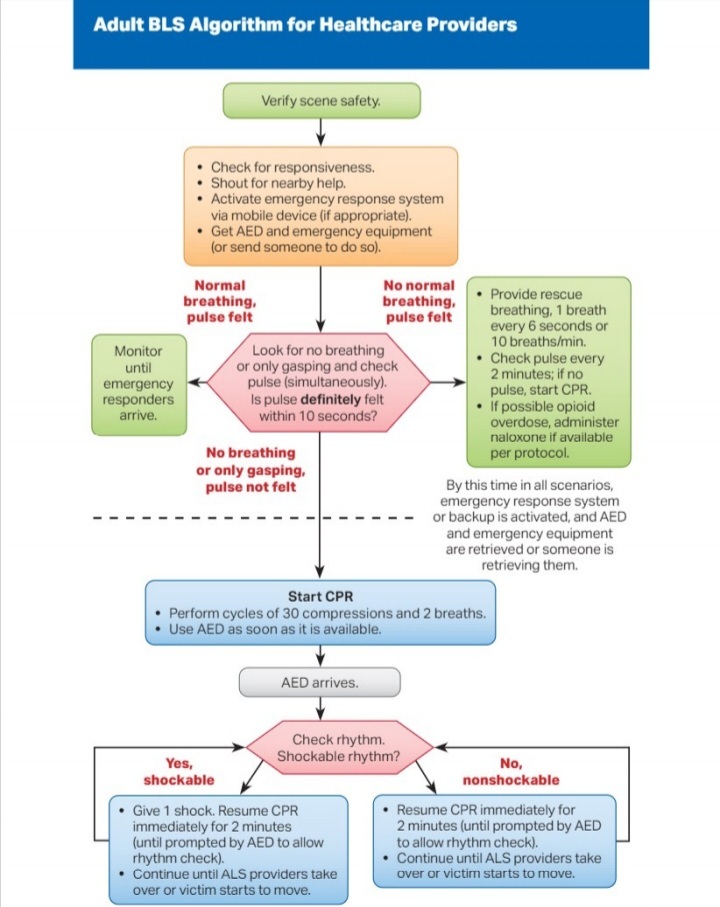(Images can be enlarged if needed)

Cardiac arrest, also known as Sudden Cardiac Arrest, is when the heart stops beating suddenly. The lack of blood flow to the brain and other organs can cause a person to lose consciousness, become disabled or die if not treated immediately.
The terms ‘heart attack’ and ‘cardiac arrest’ are often used interchangeably, but these are two different heart conditions.
A heart attack occurs when there is a blockage in the arteries that stops blood flow in the heart. Due to the lack of blood and oxygen flowing in the heart, the heart muscle tissue will become damaged. Heart attacks can increase the risk for cardiac arrest because heart attacks can alter electrical signals in the heart.
CPR – or Cardiopulmonary Resuscitation – is an emergency lifesaving procedure performed when the heart stops beating. Immediate CPR can double or triple chances of survival after cardiac arrest.
If someone experiences cardiac arrest, they need immediate treatment to increase the flow of oxygen-rich blood to their organs. CPR is the compression over the chest to manually pump a patients heart. Rescue breaths are preformed to provide oxygen to the body.
During CPR, proper hand placement on the lower half of the sternum is crucial. Placing hands over the sternum ensures effective chest compressions directly above the heart, optimizing blood circulation throughout the body.
According to the American Heart Association (AHA), the overall survival rate for out-of-hospital cardiac arrest is around 10%. However, survival rates can be improved if bystander CPR is started immediately. Studies have shown that bystander CPR increases the chances of survival for someone experiencing cardiac arrest. In fact, the AHA reports that survival rates increases to 40% or higher when bystander CPR is performed promptly. The surival rate is between 24% and 40% for those that happen in the hospital, according to the report published online in the Emergency Medicine Journal.
CPR is preformed between 100 - 120 beats per minute. Famously Staying Alive by the Bee Gees is the same beat. A large list of songs with the correct BPM can be found here
![]() The American Red Cross gives the following list of steps to asses if CPR is needed and how to preform:
The American Red Cross gives the following list of steps to asses if CPR is needed and how to preform:
1 CHECK the scene for safety, form an initial impression and use personal protective equipment (PPE)
2 If the person appears unresponsive, CHECK for responsiveness, breathing, life-threatening bleeding or other life-threatening conditions using shout-tap-shout
3 If the person does not respond and is not breathing or only gasping, CALL 9-1-1 and get equipment, or tell someone to do so
4 Kneel beside the person. Place the person on their back on a firm, flat surface
5 The American Red Cross CPR guidelines recommend 100 to 120 chest compressions per minute, 30 at a time. Remember these five points:
Hand position: Two hands centered on the chest
Body position: Shoulders directly over hands; elbows locked
Compression depth: At least 2 inches
Rate of compressions: 100 to 120 per minute
Allow chest to return to normal position after each compression
6
Give 2 breaths
Open the airway to a past-neutral position using the head-tilt/chin-lift technique Pinch the nose shut, take a normal breath, and make complete seal over the person’s mouth with your mouth. Ensure each breath lasts about 1 second and makes the chest rise; allow air to exit before giving the next breath Note: If the 1st breath does not cause the chest to rise, retilt the head and ensure a proper seal before giving the 2nd breath If the 2nd breath does not make the chest rise, an object may be blocking the airway
7 Continue giving sets of 30 chest compressions and 2 breaths. Use an AED as soon as one is available! Minimize interruptions to chest compressions to less than 10 seconds.
Sources:
https://www.hopkinsmedicine.org/health/conditions-and-diseases/cardiac-arrest
https://cpr.heart.org/en/resources/cpr-facts-and-stats
https://www.mycprcertificationonline.com/blog/cpr-success-rate
Instructional images from the AHS Basic Life Support Manual (2020)
Join our public Matrix server! https://matrix.to/#/#tracha:chapo.chat
As a reminder, be sure to properly give content warnings and put sensitive subjects behind proper spoiler tags. It's for the mental health of not just your comrades, but yourself as well.
Here is a screenshot of where to find the spoiler button.



spoiler
I have some sex shit I'm working through, as well, and I'm hoping I can get through it.
I think something that's really important is not to attach judgments to how you're reacting. You acknowledge that it's more difficult for you to engage with these things, but that's okay. Don't beat yourself up over it.
The burdens you feel won't stop, but they'll become lighter.
spoiler
Can I stop though? This is highly unproductive, I'm finding. Hate to see it.
spoiler
Stop judgment?
Definitely!
We have our primary emotions like fear or anger which can come and go seemingly without our control, but how we interpret (judge) those things after they happen is much more up to us.
For instance, a trans woman might have sex and have lot of feelings during that time. Afterwards, they will make a judgment. It might be, "I'm trying to enjoy my body the way I want" or it could be "I'm an AGP." While it may be hard to control emotions during the actual event, that judgment afterwards will be the difference between peace of mind or anguish. It's largely a choice. There's nothing in our brains that says we MUST see it one way or the other.
NO SHAME LESGO
Okay I think a wire got crossed somewhere. See, I am not ashamed of my desires:
I am very much looking forward to forgetting about my brain and wearing the pretty collar for a few hours, I think it's gonna be great. Even just thinking ahout it kind of sets my mind alight in a way nothing else does, so I'm pretty sure it's gonna rock. I will be stimming with meowing noises, and I will be enjoying it.
The trouble is actually engaging in this stuff is absurdly difficult due in part to trauma, the ex stuff y'know. I am still basically new at this so it's a lot of high emotions and there's a big chance for bad things to happen, even unintentionally, as stated. That's my worry, something unintended happening and causing a bunch more suffering for me.
spoiler
All valid fears. Just be safe and go slow
spoiler
spoiler
This sounds like garden variety anxiety
spoiler
No it's actually emotional dysregulation combining with traumatic stuff around sex to form a really nasty combination that results in extremely strong responses to anything negative happening and is deeply unfunny
spoiler
Sorry, I can only directly related to half of that. I haven't dealt with emotional dysregulation.
Hoping you get through it, though